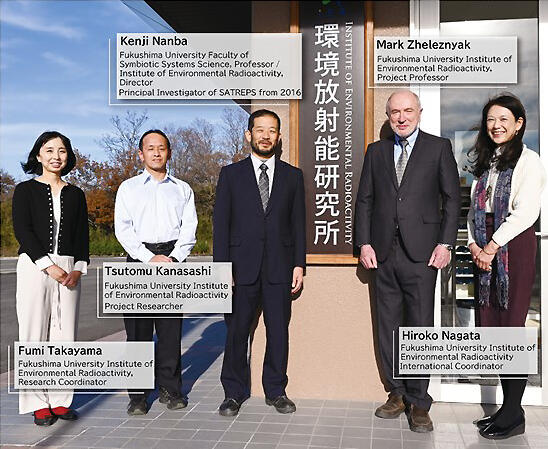
Humanity has been forced to face various hazards to date, and have been able to continue their lives by overcoming them. Ukraine and Japan, which have both been hit by unprecedented serious nuclear power plant accidents, will take on this challenge through joint international research. They will establish an observation method that can accurately assess the environment and seek means to re-inhabit the land. Additionally, they will accumulate this knowledge and pass it on to the next generation in case of future emergencies.
One clue to learning about Fukushima comes from investigating Chornobyl's "present," 25 years after the accident
As the world makes a major shift toward decarbonization, the use of renewable energy is progressing. However, the goal of ensuring zero real carbon dioxide emissions by 2050 is difficult to achieve while maintaining growth solely using renewable energy. Therefore, it is expected that the utilization of nuclear power generation, which emits relatively little carbon dioxide, will continue. According to a survey by the Japan Atomic Industrial Forum, as of January 1, 2021, more than 400 nuclear power plants were in operation worldwide, and technological developments such as the construction of new reactors and the development of small modular reactors were progressing.
However, when an accident occurs, the damage is immeasurable. One of the most infamous accidents is the Chornobyl nuclear power plant disaster that occurred in April 1986 (Fig. 1). An explosion occurred in an operating reactor, causing a core fuel and graphite fire. As a result, a large amount of radioactive iodine, cesium, strontium, and even some of the fuel, including uranium and plutonium, were scattered. The area approximately 30 kilometers from the nuclear power plant was highly contaminated with strontium-90 and cesium-137, which have a half-life of approximately 30 years, and has been designated as an "exclusion zone" to this day. Further, the area within approximately 10 kilometers contaminated with longer-lived radioactive substances such as plutonium is more strictly controlled.
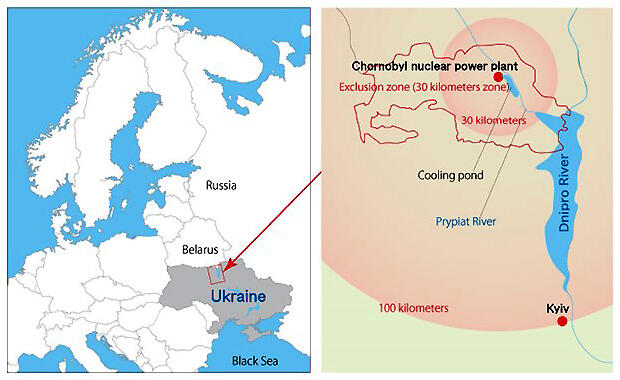
However, in recent years, movements to utilize this area have begun. "We are not thinking about returning residents, but there are moves to use it for economic activities," explains Kenji Nanba, Director of the Fukushima University Institute of Environmental Radioactivity, who is the principal research investigator. The Ukrainian government has begun to explore ways to utilize the area, which is a mixture of devastated ruins and sites of natural regeneration, such as tourism and new wind and solar power generation using existing power transmission facilities. Nevertheless, under such circumstances, issues such as creating rules for safe use of the area and zoning to reorganize new areas have emerged.
In contrast, at the Fukushima Daiichi Nuclear Power Station, the supply of cooling water to the reactor was stopped due to the effects of the March 2011 earthquake and tsunami, and an explosion occurred due to hydrogen generated at high temperatures. Because serious destruction of the core was avoided, the main radioactive materials scattered were only radioactive iodine and cesium. Currently, decontamination is progressing even in areas that were considered "difficult to rehabilitate" after the accident, and the return of residents is beginning as a path to reconstruction.
The international research "Strengthening of the Environmental Radiation Control and Legislative Basis for the Environmental Remediation of Radioactively Contaminated Sites" by the two countries that experienced such disasters began in 2016 at SATREPS. "It is expected that Chornobyl will help with understanding the situation in Fukushima in 25 years' time. It may be possible to understand the changes in radioactive cesium in the environment, which is a problem in Fukushima, going into the future. It can be considered as "time travel", says Director Nanba.
Also, as a Ukrainian, Project Professor Mark Zheleznyak of the Fukushima University Institute of Environmental Radioactivity, who has been conducting model prediction research on radioactive material migration in the natural environment, mainly in Chornobyl, explains the following advantages of the project: "It is important for Ukraine to learn from the case of Japan where the return of residents is beginning". Japanese researchers will also have the opportunity to acquire the knowledge that Ukrainian scientists have accumulated over 35 years."
Towards understand changes in the surrounding environment when the cooling water supply source water level drops
This joint research project is centered on four research topics (Fig. 2). The first is research on the cooling pond (CP), which is an artificial pond for supplying cooling water to the reactor. The second is the movement of soil and water within the exclusion zone and the accompanying movement of radioactive materials. The third is the long-distance transport of radioactive materials through the atmosphere. Finally, the group aims to summarize these outcomes and submit them to the Ukrainian government for drafting new rules for the use of the exclusion zone and recommendations that will serve as the basis for zoning.
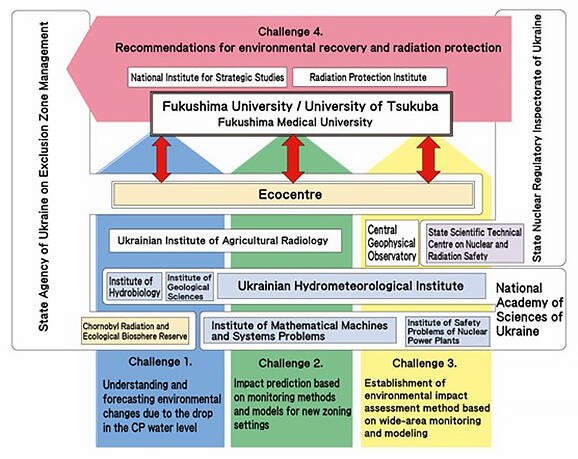
Nuclear power generation uses the heat released during the fission of uranium, converts water into high-temperature, high-pressure steam, and turns a turbine to generate electricity. This steam is cooled, and the power generation cycle is repeated. The CP is a 10 × 2 kilometer artificial pond that is responsible for cooling. Water of the Prypiat River, which is adjacent to the eastern side of the CP, has been pumped to maintain the high-water level. However, in 2014, the pump function stopped as part of the decommissioning process, and since then, the water level has dropped, leading to emergence of land (Fig. 3).
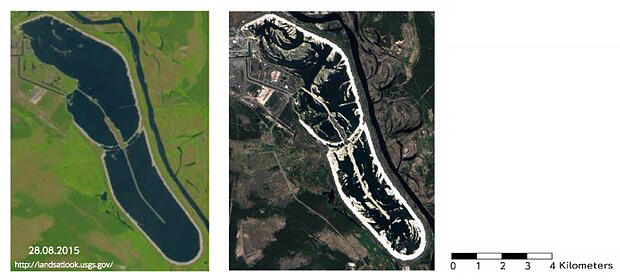
A large amount of radioactive material was dispersed and dropped into this pond near the power plant. "We are trying to understand the chemical and physical changes and effects of the drop in water level on the radioactive materials in the water and at the bottom of the pond. We are also investigating the radiation levels of the freshwater fish inhabitants and the effects on animals that move onto the land areas," explains Tsutomu Kanasashi, a Project Researcher at the Fukushima University Institute of Environmental Radioactivity (Figs. 4 and 5).
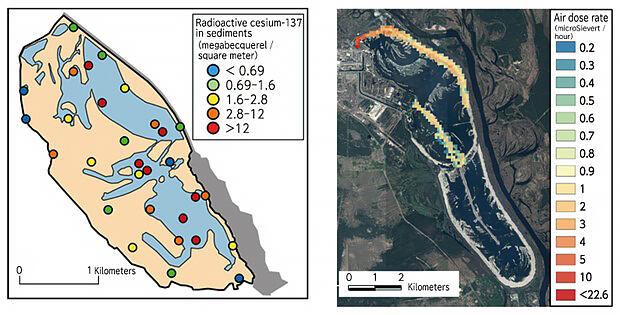
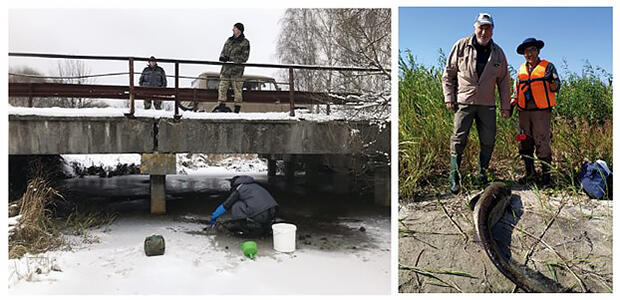
In addition, radioactive materials are likely to be transported with the movement of water in the pond. However, transport is not limited to surface water. The participation of groundwater must also be considered. Therefore, a new well for groundwater observation has been dug around the CP, and continuous monitoring for changes in flow, water level, and water quality including radioactive substances has begun.
Director Nanba and his colleagues fully utilize the hydrology knowledge from the database of water movements and corresponding changes, such as understanding the effects of a flood and the type of changes caused by fluctuation in precipitation, to develop a simulation of such fluctuations. The CP appears to be balanced with the water level of the Prypiat River. The researchers aim to understand long-term fluctuations in radioactive mass transfer through surface water and groundwater flow around Chornobyl, including the reactor that caused the accident adjacent to the CP.
Radioactive material moves outside the exclusion zone even in water, soil, and forest fires
Capturing strontium, which is water soluble, is also important, said Yasunori Igarashi, a Project Assistant Professor at the Fukushima University Institute of Environmental Radioactivity, who has been involved in field surveys since the beginning of the project. "Strontium has the potential to flow into rivers and be carried out of the affected area. We would like to determine the location and quantity of the outflow, and its determining factors," he said, and is thus conducting research on the movement of radioactive materials from inside to outside the exclusion zone.
Unlike the case in Fukushima, in the Chornobyl accident, the reactor was severely damaged, releasing fuel particles into the surrounding environment. Strontium contained in fuel particles is easily dissolved in water and transported as the fuel particles undergo weathering. Therefore, in rivers around Chornobyl, strontium released from fuel particles is still detected at high concentrations. Furthermore, the strontium concentration in river water increases during the snowmelt season. The latest findings in Fukushima have also confirmed that seasonal changes in soil freezing and thawing can alter soil erosion and transport radioactive cesium and strontium. Chornobyl studies also aim to clarify this transport mechanism as well as the relationship between seasonal changes in soil and river water.
In 2018, a forest fire broke out in the exclusion zone. In forest fires, ash containing plant-derived lipids accumulates on the ground. These impede soil drainage; when it rains, the surface sediment is likely to wash away. Sediment containing combustion ash has radioactive substances that are taken up and accumulated by plants, which is a remarkable event from the viewpoint of remobilization. It has been clarified that the movement of this sediment is approximately 3.7 times greater at the forest fire site than in the normal forest area, and the concentration of the mobile radioactive cesium has increased approximately 30-fold.
In response to this result, Professor Igarashi explains: "Since this fire occurred far from the river, we believe it is unlikely that sediment will flow directly into the river." Fortunately, the impact outside the area is expected to be low. However, in 2020, another large-scale forest fire occurred, burning one-third of the forest in the area. Hence, it is necessary to clarify the relationship between the transport of sediment generated from here and the surrounding rivers and understand its impacts.
In addition, it is important to understand the distribution of forest biomass and the amount of radioactive substances contained therein, which is crucial for early assessment of the effects of forest management and fires. Professor Igarashi and others have developed a new method using drones to efficiently monitor and evaluate these metrics within the exclusion zone where field study time is limited (Fig. 6). As a result, the distribution and growth of forest biomass has been observed and mapped, along with acquiring accurate data. If this result can be applied practically, it will be possible to reduce the exposure dose of workers conducting surveys in high-radiation dose areas. Furthermore, it will be possible to conduct surveys using high-performance drones even in forests in the low-access areas of Fukushima, which have complex terrain.

Measurements obtained with equipment mounted on the vehicle can be immediately published to provide a sense of security
"There is concern among residents that the effects of radioactive materials may change if forest fires or floods occur around Chornobyl. Rumors spread easily; hence, it is important to provide accurate information," says Professor Zheleznyak, who investigates the broad-scale movement of radioactive materials. Even prior the project, he was a leading researcher working in this field for many years.
When a fire occurs in Chornobyl, the smoke reaches the capital Kyiv, which is 100 kilometers away. Fixed-point observations cannot be applied to remobilization monitoring of radioactive materials due to smoke, and it is necessary to make accurate observations at the points of smoke passage. In response, Ukraine has facilitated mobile observation using a vehicle-based "Mobile Laboratory" equipped with analytical equipment.
However, action after confirming the arrival of smoke was insufficient, and thus far, opportunities to make effective observations have been missed. Therefore, in this joint research, the group modeled smoke movement and attempted to predict the arrival point. As a result, it was possible to detect the effects of forest fires that occurred twice in 18 and 20 years with accurate values (Figs. 7 and 8). Despite the effects of the fire, it became clear that the observed contamination values did not exceed the Ukrainian standards, and the results were immediately announced. Accordingly, the citizens were convinced of their safety and reassured.
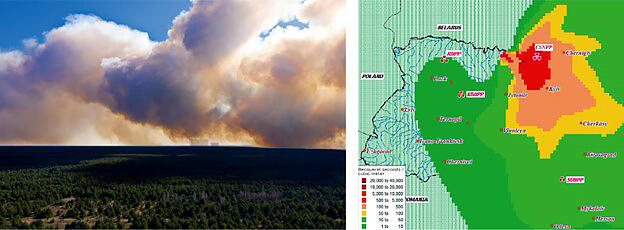
(from Talerko et al., 2021 Atmos. Pollut. Res.)
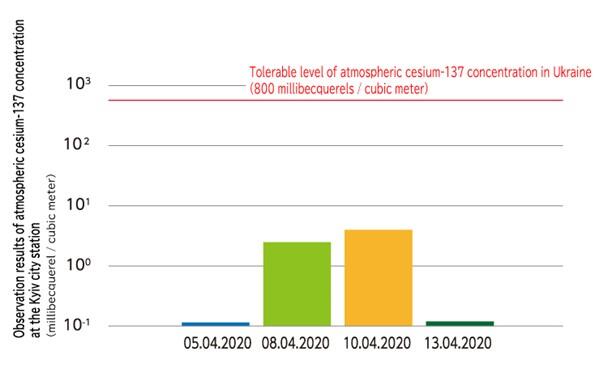
Thus, modeling and mobile laboratories are used to establish a new unique method for understanding the effects of fire. "Forest fires are rare in Japan, but we think there will be situations where the technology can be applied," says Professor Zheleznyak. In the future, he is eager to develop a study that targets strontium remobilization in river water due to floods and its impact on tap water sources in Kyiv.
Due to historical events, Ukraine has been in a state of economic instability. This has meant that research has been conducted using the same analytical equipment since the time of the accident. However, science and technology have made great advances in the 25 years leading up to the Fukushima Daiichi nuclear accident. Equipment and methods for analyzing radioactive substances with high accuracy and efficiency are also being established.
Under these circumstances, Ukraine requires active cooperation and advice from other countries to address the challenge of reorganizing the exclusion zone. It is expected that the concrete proposals on environmental recovery and radiation protection that will be assembled by Director Nanba as the final project goal will influence the future of Chornobyl.
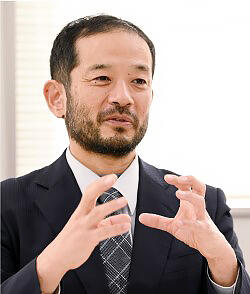
Ongoing themes and seeking means of international contribution
Originally a specialist in environmental microbiology, Director Nanba has investigated soil and river formation and the functions of the inhabitant microorganisms. Shortly after he joined Fukushima University, he experienced the great earthquake in March 2011. "Looking back at my research, I have followed the process of microorganisms treating and purifying pollutants emitted by human activities. After the earthquake, I read radiation-related papers and rented equipment to start an investigation, thinking that I might be able to take some action myself," he recalls.
Director Nanba says that radioactive substances that were unintentionally incorporated into the natural world could act as tracers; considering this perspective of material circulation, it is now possible to determine the flow of substances. Additionally, he notes that these discoveries have increased interest in basic scientific research in this field.
For example, there are morphologically abnormal pine trees in the exclusion zone. It is assumed that this is a result of impaired hormone function during growth due to the effects of radioactive substances. However, to clarify this, it is necessary to understand the growth mechanism of pine trees, which has not been clarified. In this way, Director Nanba indicated that new and diverse themes are expanding from research on environmental radioactivity, and he is eager to contribute to basic research.
This project, which started in 2016 and is scheduled for 6 years, has reached its final stage. The project's efforts and knowledge have attracted attention from specialized institutions and educational venues, and the opportunities for invitations to provide lectures and classes have increased. From the perspective of education and social return, he says that he will seek ways to contribute internationally by utilizing the achievements of both countries and fulfilling his responsibilities to Japan.
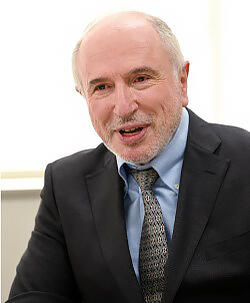
Even after 35 years, some residents still want to return to Chornobyl. In addition, there is an area with high internal exposure that is thought to be caused by the intake of contaminated food at a point 200-300 kilometers from the exclusion zone. The effects of radioactive materials are widespread and long-term, and much remains to be understood. Fukushima and Chornobyl continue to present novel challenges for humankind. There is great interest in the future development of this project, which addresses ongoing themes, including basic scientific inquiry.
This interview was conducted in November 2021 and the original Japanese version was published in February 2022. All positions are as of the time of the interview.




